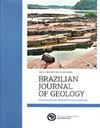Geochemistry, Sm-Nd isotopes and SHRIMP U-Pb geochronology of the Morro do Coco Granite (RJ, Brazil): another piece of the post-collisional magmatism of the Ribeira Belt
IF 0.9
4区 地球科学
Q3 GEOSCIENCES, MULTIDISCIPLINARY
引用次数: 5
Abstract
The Morro do Coco granite (MC) is a post-collisional intrusive body that was emplaced at Ribeira Belt, in the Cambro-Ordovician, succeeding the final stages of the Gondwana supercontinent amalgamation. This unit requires more studies, contrasting with similar best investigated occurrences of the central Ribeira Belt. This work presents a detailed investigation of such unit using petrography, Inductively Coupled Plasma (ICP), X-Ray Fluorescence (XRF) whole-rock geochemistry, U-Pb (SHRIMP) geochronology and Sm-Nd isotopes. The rock is a nearly undeformed syenogranite, geochemically classified as a high-K calc-alkaline magnesian, with metaluminous to slightly peraluminous affinity. Strongly light rare earth elements (LREE)-enriched patterns with significant negative Eu anomalies, typical of post-collisional granites, are identified. Similarly to other post-collisional granites of the central Ribeira Belt, U-Pb zircon data provide crystallization age of 496 ± 3 Ma . Sm-Nd isotopic data suggest crustal magma source as indicated by εNd(496) of -9, 143Nd/144Nd ratios between 0.511747 and 0.511752 and Mesoproterozoic TDM ages of 1.3 Ga. Based on its geochemical characteristics, morphology and geochronology, this unit is considered here as a member of Nova Friburgo Suite. Geochronological data defined three pulses of magmatism in this part of the orogen during the Cambro-Ordovician (515, 490 and 460 Ma).Morro do Coco花岗岩(RJ,巴西)地球化学、Sm-Nd同位素和SHRIMP U-Pb年代学:Ribeira带碰撞后岩浆活动的另一块
Morro do Coco花岗岩(MC)是继Gondwana超大陆合并的最后阶段之后,位于寒武-奥陶系Ribeira带的一个后碰撞侵入体。这个单元需要更多的研究,与里贝拉带中部类似的最佳调查事件形成对比。本文利用岩石学、电感耦合等离子体(ICP)、x射线荧光(XRF)全岩地球化学、U-Pb (SHRIMP)地质年代学和Sm-Nd同位素对该单元进行了详细的研究。岩石为几乎未变形的同长花岗岩,地球化学分类为高钾钙碱性镁质,具有铝质至略过铝的亲和力。强轻稀土元素(LREE)富集模式具有显著的负Eu异常,是典型的碰撞后花岗岩。与里贝拉带中部其他碰撞后花岗岩相似,U-Pb锆石数据显示其结晶年龄为496±3 Ma。Sm-Nd同位素数据表明,εNd(496)值为-9,143Nd/144Nd比值为0.511747 ~ 0.511752,中元古代TDM年龄为1.3 Ga。根据其地球化学特征、形态和年代学特征,该单元被认为是Nova Friburgo套件的一员。地质年代学资料确定了寒武纪-奥陶世(515、490和460 Ma)这部分造山带有三次岩浆活动脉冲。
本文章由计算机程序翻译,如有差异,请以英文原文为准。
求助全文
约1分钟内获得全文
求助全文
来源期刊

Brazilian Journal of Geology
GEOSCIENCES, MULTIDISCIPLINARY-
CiteScore
3.20
自引率
7.10%
发文量
12
审稿时长
11 weeks
期刊介绍:
The Brazilian Journal of Geology (BJG) is a quarterly journal published by the Brazilian Geological Society with an electronic open access version that provides an in-ternacional medium for the publication of original scientific work of broad interest concerned with all aspects of the earth sciences in Brazil, South America, and Antarctica, in-cluding oceanic regions adjacent to these regions. The BJG publishes papers with a regional appeal and more than local significance in the fields of mineralogy, petrology, geochemistry, paleontology, sedimentology, stratigraphy, structural geology, tectonics, neotectonics, geophysics applied to geology, volcanology, metallogeny and mineral deposits, marine geology, glaciology, paleoclimatology, geochronology, biostratigraphy, engineering geology, hydrogeology, geological hazards and remote sensing, providing a niche for interdisciplinary work on regional geology and Earth history.
The BJG publishes articles (including review articles), rapid communications, articles with accelerated review processes, editorials, and discussions (brief, objective and concise comments on recent papers published in BJG with replies by authors).
Manuscripts must be written in English. Companion papers will not be accepted.
 求助内容:
求助内容: 应助结果提醒方式:
应助结果提醒方式:


